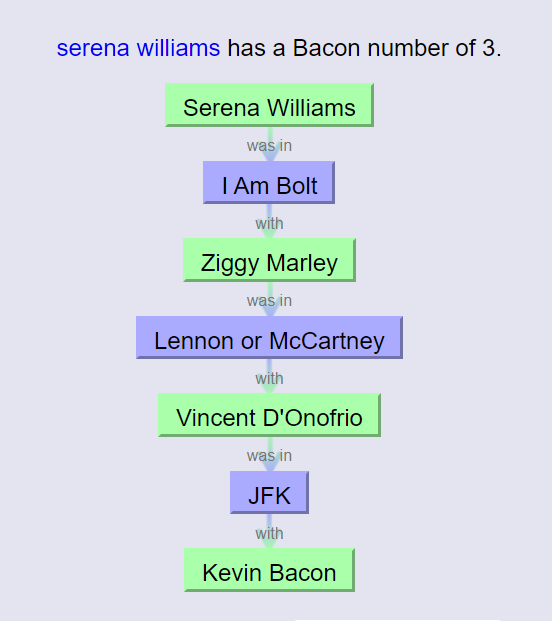In many ways, the early days of tennis seem impossibly ancient. It was a time of long skirts, wooden rackets, and underhand serves that were in no way tactical. Sometimes, though, the century and a half of lawn tennis feels like almost nothing.
After stumbling across a mention of a 1951 professional match between Bill Tilden and Pancho Gonzales, I took to Twitter:
The path from Tilden to Federer–or one of many other active players–requires only three intermediate steps.
If we expand the types of links we’re willing to consider, the connections are almost overwhelming. From the 1931 men’s champion of Black tennis, forbidden from entering the US National Championships, you can get to Svetlana Kuznetsova in only three steps:
If we stick to women’s singles, the paths are a bit longer, because fewer women played for as long as the likes of Tilden and Gonzales, especially in the amateur era. Yet it still only takes five steps to travel from 1908 US champion Maud Barger-Wallach to Venus Williams:
If you’ve ever played Six Degrees of Kevin Bacon, you know how addicting this kind of thing can be. And you can guess how productive I was at work today while mulling the kinds of paths that can be constructed between early tennis and the present.
But wait, there’s math!
Is my path from Tilden to Federer the optimal one? Could we construct a smaller set of connections between Barger-Wallach and Venus Williams? Like many pursuits that start out as time-wasters, this is a math problem that we can solve.
In a different domain, the Oracle of Bacon offers just that sort of solution, calculating the shortest path between Kevin Bacon and any actor, where each step is a film that “connects” any pair of cast members. For example, Serena Williams has a “Bacon number” of 3:

Academics have “Erdős numbers” and you can see how baseball players are connected with the Oracle of Baseball at baseball-reference.com.
These solutions come from the field of graph theory, which includes many algorithms that address this sort of problem. (As well as real problems that are relevant to the real world.) Checking every possible path between actors, academics, or baseball players is extremely computationally intensive, so different techniques take varying approaches to trimming the number of paths worth investigating. One of these algorithms, breadth-first search, is efficient enough that it can identify the shortest route from a half-million tennis matches on my laptop in a few seconds.
Gore to Djokovic
Let’s see what this Oracle of Tennis can tell us. The first Wimbledon champion, in 1877, was Spencer Gore. He was no Pancho–he played The Championships only one more time. The Oracle will have some work to do to get from Gore’s corner of the graph to the modern era.
It turns out that the shortest path from Gore to Novak Djokovic–the first Wimbledon winner to the reigning titleholder–takes nine steps:
Spencer Gore vs Montague Hankey (1877 Wimbledon)
Hankey vs Charles Lacy Sweet (1883 Cirencester Park)
Sweet vs George Lawrence Orme (1884 Sussex County)
Orme vs Max Decugis (1901 French Covered)
Decugis d Coco Gentien (1924 Coupe de Noel)
Gentien vs Pancho Gonzales (1949 Roland Garros)
Gonzales vs Jimmy Connors (1971-73, 4 meetings)
Connors vs Fabrice Santoro (1992 Vienna)
Santoro vs Novak Djokovic (2007-08, 2 meetings)
That isn’t the only nine-step path from Gore to Djokovic, but there are none shorter. Many of the most efficient routes involve the same players. Gore didn’t give us many opponents to choose from, so the relatively(!) long career of Montague Hankey is a common first step. And the final sequence of Pancho-to-Connors-to-Santoro-to-Djokovic (and many other present-day stars) is tough to beat.
Sutton to Raducanu
Historical women’s tennis data isn’t in quite as good of shape as men’s–yet. Thanks to TennisArchives.com, we can scan hundreds of thousands of men’s results from the amateur years in addition to the usual Open Era records. I’ve pushed my dataset of historical women’s results back to 1917–a huge improvement over the state of affairs a year ago, but missing the first few decades of tournaments.
We can still reach quite far back. Two-time Wimbledon champ and winner of the 1904 US National Championships, May Sutton Bundy was part of a Southern California tennis dynasty and one of the greats of her era. After giving birth to four kids in the 1910s, she returned to competitive tennis and won singles titles as late as 1928.
So even though we don’t yet have her entire career record in the database, we can use the Oracle to link her to the present. It takes only seven steps to get from Sutton to 2021 US Open champ Emma Raducanu:
May Sutton Bundy vs Marion Zinderstein Jessup (1921 Seabright)
Jessup vs Betty Rosenquest Pratt (1943 Wilmington)
Pratt vs Christine Truman (1957-59, 3 meetings)
Truman vs Martina Navratilova (1973 Wimbledon)
Navratilova vs Ai Sugiyama (1993 Tokyo)
Sugiyama vs Stefanie Voegele (2006 Fed Cup)
Voegele vs Emma Raducanu (2021 US Open)
I don’t know what else to add–this was a weird day.